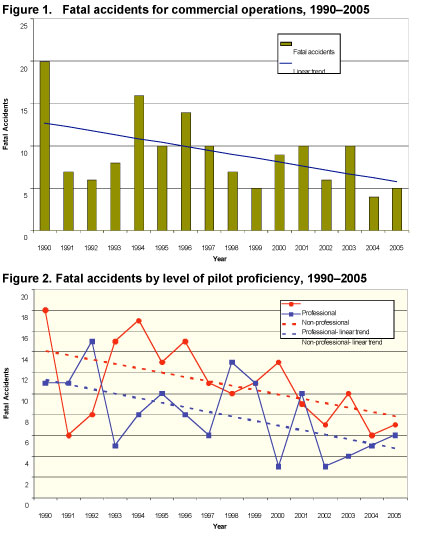ATSB data and analysis released today refutes recent claims reported in the media that the commercial aviation fatal accident rate in Australia is increasing and that the number of aviation fatalities involving professional pilots in Australia over the last three years is very high compared with the years since 1990.
Australia still has the best international record in high-capacity regular public transport (RPT) with no hull losses or fatal accidents involving passenger jet aircraft.
Even using the broadest definition of commercial aviation to include both RPT and General Aviation except for business/private and sport aviation, shows a significant decrease in the number of fatal accidents between 1990 and 2005 (Fig 1). Although there was an increase in fatal accidents and fatalities for commercial operations during 2005, 2004 was the lowest recorded for the period examined for each measure.
Using the broadest definition of professional pilot, the data show no significant trend in fatalities involving professional pilots from 1990 to 2005 but a significant decline in the fatal accident trend (Fig 2). Fatal accidents and fatalities involving professional pilots were much higher compared with private pilots in 1993, 1994 and 2000 than in 2003, 2004 and 2005. The gap (related to hours flown) is neither recent nor growing.
Between 1990 and 2004 (the last year for which activity data is available) commercial aviation operations recorded an average of 0.6 fatal accidents per 100,000 hours flown compared with an average of 2.4 fatal accidents per 100,000 hours flown for non-commercial operations.
There were four low capacity RPT fatal accidents involving 32 fatalities recorded in the ATSB database from 1990 to 2005 including a 1995 training accident in which there were no passengers on board. The other three low capacity RPT accidents were Monarch (1993), Whyalla (2000) and the recent accident at Lockhart River.
The ATSB found that the total number of fatal accidents and fatalities declined significantly in the period from 1990 to 2005. The largest number of fatal accidents (30) and fatalities (64) was recorded in 1990. The lowest number of fatal accidents (10 and 11) and fatalities (24 and 23) occurred in 2002 and 2004. In 2005 there was an increase in the number of fatal accidents and fatalities to 13 and 34 respectively compared with 2004. But the number of fatal accidents and fatalities reported in 2005 was below the annual average (20 and 40 respectively) for the 16-year period.
While any aviation fatality is a tragedy and we must never be complacent, the ATSB's analysis show that the fatal accident rate for both commercial and non-commercial operations is very low and has declined significantly from 1990 to 2005.



